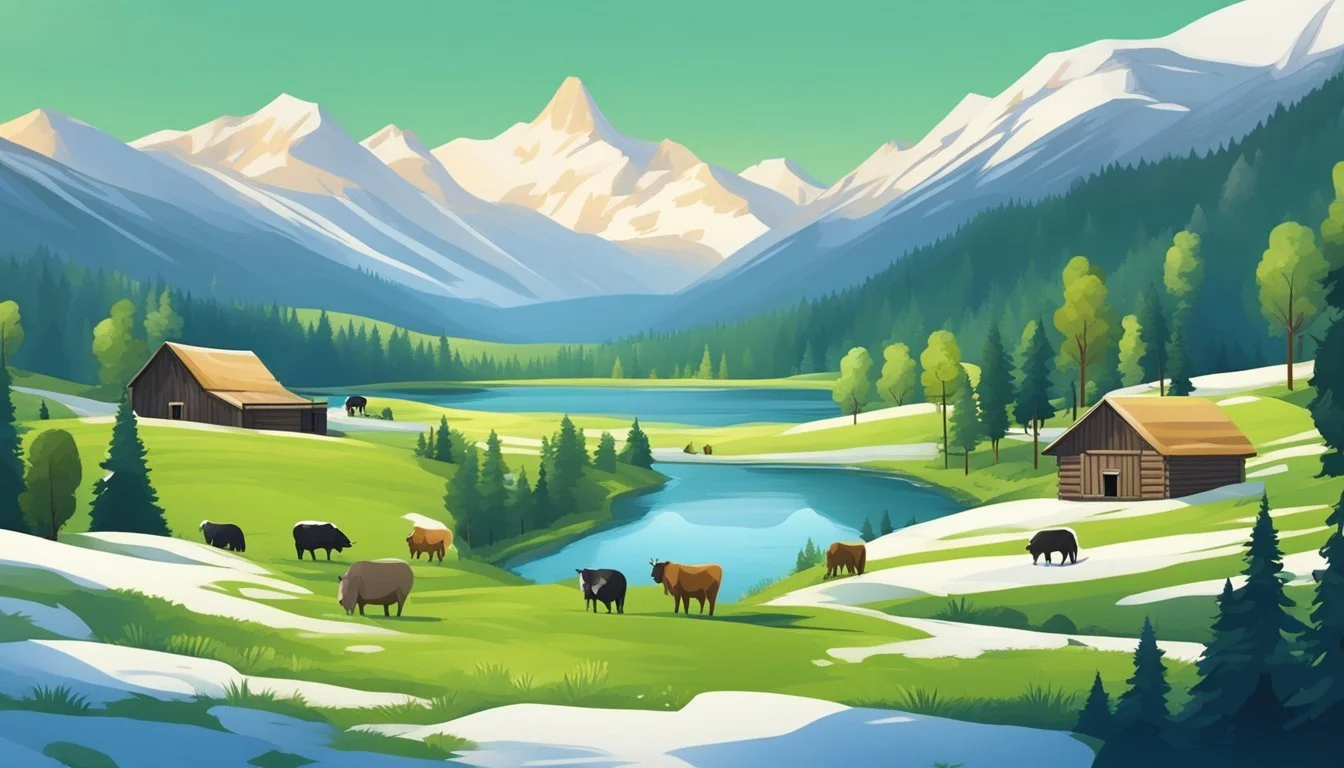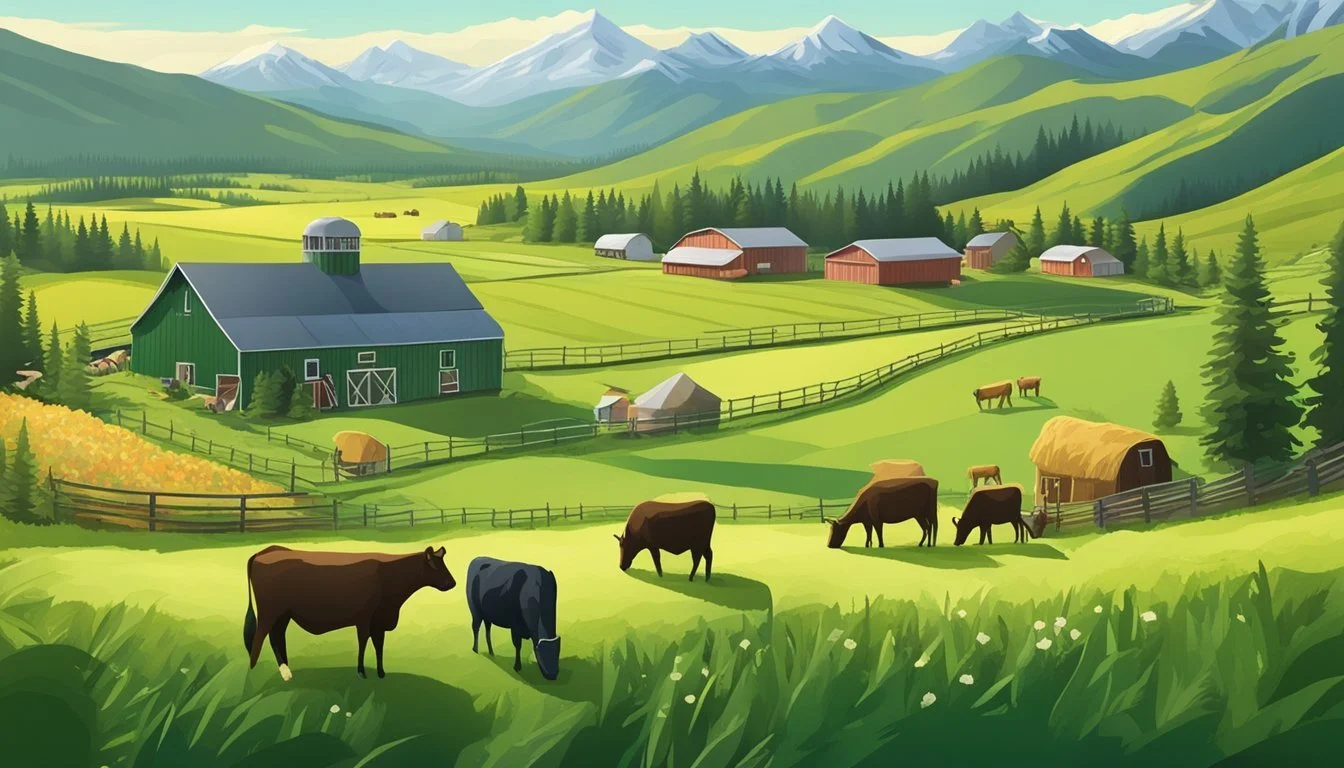Agritourism in Alaska
Exploring the Frontier of Farm-Based Travel
Agritourism in Alaska is a growing industry harnessing the state’s unique agricultural capabilities and stunning landscapes. With the rise of farm and ranch tours, visitors have the opportunity to witness the diversity and resilience of Alaska's agricultural sector. Agriculture may not be the first industry that comes to mind when thinking of the northernmost U.S. state, but for the intrepid traveler, Alaska offers a variety of unique farming experiences set against the backdrop of its impressive geographical tapestry.
Farm tours in regions such as the Matanuska-Susitna Valley allow visitors to explore the local produce and participate in an authentic farm-to-picnic experience. In Palmer, tourists can engage with the land, learning how to prepare genuine Alaskan meals using fresh farm ingredients. These hands-on experiences provide insight into the daily life and challenges of farming in the harsh Alaskan climate, while emphasizing the innovation and hard work of local farmers.
Incorporating aspects like educational tours, cooking classes, and direct farm sales, agritourism in Alaska is not only a way for tourists to discover the state's lesser-known agricultural narrative but also a vital means for farmers to supplement their income. From hand-woven garlic braids in Homer to the synergistic efforts at local gardens, each agritourism destination in Alaska crafts a unique story that contributes to the state’s economic diversity.
The Concept of Agritourism
Exploring the intersections of agriculture and tourism reveals a burgeoning niche in travel: agritourism. Particularly in Alaska, this fusion offers a unique lens to experience the state's rural economy and landscape.
Defining Agritourism
Agritourism is defined as an activity that combines agricultural operations with tourism to attract visitors to farms, ranches, and other agricultural settings. It offers tourists the chance to engage with the food production process, often through activities like fruit picking, farm stays, and educational tours. The U.S. Department of Agriculture recognizes agritourism as a valuable avenue for farm income diversification and rural development.
Importance for Alaska
In Alaska, where farming can be challenging, agritourism represents an opportunity for agricultural business owners to expand their revenue streams. The state's unique climate and geography limit the types of produce that can be grown, yet the variety that does thrive, such as the produce cultivated by Synergy Gardens in Homer, becomes a focal point for agritourism experiences. According to the National Agricultural Statistics Service, Alaska boasted over 1,000 farms generating revenue in 2021, and direct sales and agritourism are playing an increasing role in bolstering these figures. Visitors can often participate in farming tasks, thereby gaining an authentic glimpse into Alaskan agricultural life and supporting the local economy.
Alaskan Agritourism Destinations
Alaska's agritourism destinations offer a unique blend of adventure, agriculture, and local cuisine, presenting tourists with genuine farm-to-table experiences and a closer look at the state's diverse agricultural practices.
Palmer Area Attractions
Palmer, renowned for its fertile soil and farming community, boasts several Palmer-area farms that have embraced agritourism. Visitors can embark on Alaska Farm Tours, which highlight the agricultural heritage of the region. They can enjoy the Palmer Farm-to-Picnic Tour, learning to cook using local ingredients while exploring multiple farms within the area.
Denali Region Experiences
The Denali region, usually associated with stunning landscapes and wildlife, also offers unique agritourism experiences. Agricultural tours here might include visits to local farms where visitors can witness the challenges and rewards of farming in the Alaskan wilderness. Tours might cover practices of sustainable agriculture against the majestic backdrop of Denali.
Kenai Peninsula Farms
The Kenai Peninsula serves as a prime spot for those interested in fishing and farms. Here, agritourism includes exploring local fisheries and learning about the fish lifecycle, as well as visiting farms that may offer u-pick berries, flower gardens, and an assortment of locally grown products.
Sitka Local Foods Network
In Sitka, the Local Foods Network champions the growth, education, and distribution of local foods. Visitors can engage with community gardens, participate in educational programs, or attend local farmers markets, providing a deep dive into the coastal community’s dedication to sustainable food practices.
Interior Farms and Ranches
Alaska’s interior offers an array of interior farms and ranches that introduce visitors to the heartland's agrarian way of life. Guests might find themselves marveling at the resilience required to manage livestock or grow crops under the Northern lights. The Great Alaskan Cattle Drive, for example, offers a hands-on experience of ranch life, complete with authentic chuck wagon cooking.
Farm and Food-Based Activities
Exploring the bounty of Alaska through farm and food-based activities provides an authentic taste of the region's agriculture and culinary heritage. From hands-on farm tours to community-driven food festivals, visitors have an array of options for dive into the local agrarian lifestyle.
Guided and Self-Guided Farm Tours
Visitors can embark on guided tours to learn about sustainable farming directly from the producers. These tours often include demonstrations of renewable energy systems and a chance to interact with a variety of livestock. For those preferring flexibility, self-guided tours allow travelers to explore at their own pace, visiting farms such as Blood Sweat & Food Farms in Homer, known for pasture-raised meats.
Farm-to-Table Dining
Farm-to-table dining in Alaska delivers a fresh and authentic culinary experience. Local restaurants often feature house-made dishes crafted with locally sourced ingredients, such as the lemon basil dressing celebrated at some establishments. These dining experiences support food security and celebrate Alaska’s unique agricultural offerings.
Farm-Involved Events
Alaska’s agritourism is not complete without participating in farm-involved events. These events cater to a range of interests, from the Palmer Farm-to-Picnic Tour blending culinary arts with agriculture to programs by Sitka Local Foods Network that promote local food education and community involvement.
Harvest Moon Local Food Festival
The Harvest Moon Local Food Festival is a seasonal highlight, bringing together farmers, locals, and visitors. This festival, championed by organizations like the American Indian Alaska Native Tourism Association (AIANTA), showcases the rich tapestry of Alaskan agriculture and reinforces the importance of locally sourced produce in enhancing food security.
Unique Alaskan Agritourism Features
Alaskan agritourism embraces the uniqueness of the region’s farming, offering experiences that range from the traditional to the exotic. Visitors can explore various farm operations, including dairy and livestock farms, and encounter distinctive wildlife like reindeer and bison (What wine goes well with bison?), all while learning about innovative agricultural practices like hydroponic farming.
Dairy and Livestock Farms
Dairy and livestock farms are a staple of Alaska’s agritourism. Visitors can tour working farms where cattle and yaks are raised, gaining insight into the dairy production process. Alaska's smaller-scale operations offer a personal touch, where participants can sometimes be involved in farm activities.
Cattle: Includes tours and hands-on experiences
Dairy Production: Visitors learn about milking and processing
Reindeer and Bison Encounters
Alaska offers unique wildlife encounters that distinguish its agritourism from anywhere else. Reindeer farms provide educational tours where visitors can feed and interact with these Arctic animals.
Reindeer: Opportunities to feed and learn about husbandry
Bison: Farms exhibit the importance of bison meat in local agriculture
Fishing and Seafood Packages
Given its extensive coastlines, Alaska's agritourism includes tailored fishing and seafood packages. Tourists can participate in catch-and-cook adventures, promoting a deep connection with the region’s seafood industry.
Fishing Packages: Include guided tours and cooking seafood
Seafood: Emphasis on locally sourced fish and shellfish
Hydroponic and Greenhouse Innovations
Hydroponic farms and greenhouses represent Alaska's innovative agricultural solutions to the challenging climate. These farms produce a variety of greens and herbs year-round, showcasing the adaptability of Alaskan growers.
Hydroponic Farm: Exhibits soil-less growing techniques
Greenhouse: Demonstrates extended growing seasons despite the harsh weather conditions
Sustainability and Conservation
Agritourism in Alaska places a strong emphasis on sustainability and conservation, with farm owners and organizations uniting to promote responsible practices that contribute to food security and environmental stewardship.
Sustainable Farming Practices
Sustainable farming practices are integral to Alaska's agricultural community. These practices include the use of cold-climate adapted species and innovative growing methods suitable for the Alaskan environment. Synergy Gardens and Blood, Sweat, & Food Farms are examples of local agricultural enterprises that prioritize environmental health, food quality, and community well-being.
Synergy Gardens: Implements cold-hardy crop rotations and soil management practices that preserve the integrity of the land.
Blood, Sweat, & Food Farms: Focuses on holistic farming methods, creating an agricultural system that contributes to local ecosystems rather than depleting them.
Alaska Farmland Trust's Role
The Alaska Farmland Trust plays a crucial role in the conservation of agricultural land in the state. It works to:
Preserve Farmland: Ensures that agricultural lands are kept for farming use and not lost to development.
Support Farmers: Provides resources and guidance to help local farmers maintain sustainable operations.
The Trust's initiatives safeguard the future of agriculture in Alaska, potentially increasing agritourism revenue by preserving land for agricultural tourism.
Synergy Gardens and Blood, Sweat & Food Farms
Both Synergy Gardens and Blood, Sweat, & Food Farms exemplify the fusion of sustainability and agritourism. They actively contribute to conservation efforts and generate revenue through agritourism by inviting visitors to:
Tour their farms: Offers a hands-on experience with sustainable farming practices.
Purchase local produce: Encourages visitors to buy local products, boosting the local economy and reducing food miles.
These enterprises demonstrate that sustainable farming and conservation can coexist with a thriving agritourism sector in Alaska.
Cultural and Educational Experiences
Alaska offers educational and cultural tour experiences that provide a profound understanding of the region's agricultural practices and their cultural significance. Visitors can expect hands-on participation and insight into the local traditions of farming and cattle ranching.
Community Supported Agriculture
Community Supported Agriculture (CSA) in Alaska, particularly through platforms like KenaiLocalFood.org, promotes a partnership between local farmers and community members. Consumers support their local farmers by subscribing to the harvest of a certain farm or group of farms, often receiving weekly shares of vegetables, fruits, and other farm products. This model helps boost the economy of local communities and ensures fresher, locally-harvested food for consumers.
Great Alaskan Cattle Drive
The Great Alaskan Cattle Drive offers a rare immersion into the world of Alaskan cattle ranching. Tourists are invited to partake in an authentic chuck wagon experience, complete with cooking and gear reminiscent of the traditional methods used by ranchers past and present. It's not just a tour; it’s a step back into the history of Alaskan cattle drives and a nod to the state's rich ranching heritage.
Educational Tours and Programs
Alaska's educational tours and programs are designed to provide tourists with an extensive understanding of the state's indigenous cultures and the modern-day practices of agrarian living. Guided tours give an in-depth look into how the traditions of native communities are interwoven with current agricultural practices. This educational component is central to Alaska’s agritourism, offering insights into sustainable farming and the preservation of cultural heritage.
Seasonal Aspects of Alaskan Agritourism
Alaskan agritourism capitalizes on the unique seasonal variations of the state, offering diverse experiences in summer and winter that cater to a wide range of interests.
Summer Events and Activities
In summer, the near-constant daylight conditions fuel an explosion of agricultural abundance. Visitors can immerse themselves in activities ranging from farm-to-picnic tours to hands-on farming experiences.
Farm Tours: Touring local farms, visitors witness record-size vegetables, like the world-record 19-pound carrot, made possible by the prolonged sunlight.
Cooking Classes: Some farms offer cooking classes where participants can learn to prepare authentic Alaskan meals with freshly sourced ingredients.
Winter Agritourism Offerings
Winter brings a different kind of charm to Alaskan farms, with offerings that embrace the cold and snow.
Chuck Wagon Experiences: Visitors can engage in historical chuck wagon cookouts, reminiscent of the Great Alaskan Cattle Drive, providing a taste of frontier life.
Winter Greenhouses: Agritourism doesn't halt with the cold; some farms utilize greenhouses to grow produce year-round, demonstrating techniques for winter farming in Alaska.
Economic Impact of Agritourism
In Alaska, agritourism is a budding segment within the wider agricultural sector. It is helping to diversify the state's economy by introducing new forms of revenue and commercial activity.
Effect on Local Economy
Alaska's economy benefits from agritourism as it supplements traditional agricultural revenue with tourism-related income. In 2021, agricultural activities amassed cash receipts worth approximately $43.8 million, with miscellaneous crops, floriculture, and hay being the top commodities. Agritourism contributes to these figures by introducing alternative revenue streams for farmers, such as on-farm events and activities. The growth in agritourism has been notable. Between 2002 and 2017, revenue from agritourism activities in the United States nearly tripled, signaling a similar potential for economic impact within Alaska's regions involved in agritourism.
Fairbanks Economic Development Council Initiatives
The Fairbanks Economic Development Council (FEDC) actively initiates programs aimed at enhancing the economic prosperity of the Fairbanks area. Agritourism plays a role in these initiatives as it attracts tourists to rural areas, promoting local agriculture and providing educational experiences that can lead to increased consumer spending on local products. By focusing on developing agritourism, the FEDC aims to create a sustainable economic ecosystem that bolsters both the agricultural and tourism sectors in Fairbanks. The inclusion of agritourism within the FEDC's remit demonstrates its understanding of the interconnectivity between the agriculture and tourism industries, and its potential to stimulate Fairbanks’ broader economic growth.
Challenges and Opportunities
The growth of agritourism in Alaska offers unique challenges and opportunities, addressing issues of food security and local supply while striving for a balance between increased tourism and conservation efforts.
Food Security and Local Supply
Alaska's agritourism is tied to its food security and local supply lines. Given its geographic isolation, transportation of imported food products is costly, leading to higher prices for consumers. Agritourism can help combat these challenges by:
Supporting local farms: Tourists visiting these farms can directly purchase fresh produce, contributing to the farms' revenue and promoting the local food market.
Educating consumers: Agritourism provides an avenue for educating visitors about the importance and benefits of a strong local food system.
Encouraging local production: With initiatives like hydroponic farming, year-round production of greens, lettuces, and herbs is feasible, even in colder climates.
Balancing Tourism with Conservation
As agritourism brings more tourists to rural and pristine areas, the conservation of Alaska's natural resources becomes a critical concern. Key strategies include:
Implementing sustainable practices: Ensuring that tourism activities do not harm local ecosystems but instead contribute to their well-being.
Raising awareness: Education through agritourism can raise tourist awareness about the importance of conservation and the delicate balance of Alaska's environment.
By focusing on the dual goals of enhancing food security and managing tourism responsibly, Alaska can maximize the benefits of agritourism while safeguarding its natural assets for future generations.
Planning Your Agritourism Adventure
When planning an agritourism adventure in Alaska, travelers should focus on creating a detailed itinerary that offers rich experiences at farms and local agricultural sites. Accommodations and travel logistics require careful consideration due to the vastness and variable weather of the state.
Creating an Itinerary
Research: Identifying farms and agricultural tours should be step one, with options such as the Palmer Farm-to-Picnic Tour.
Duration: Estimate the time each activity will take; for example, some tours last approximately four hours.
Group Size: Check the group size limit for tours, as some are limited to 3-12 participants.
Variety: Incorporate different types of agritourism activities—such as farm stays and food tastings—to enrich the Alaskan experience.
Booking: Reserve spots ahead of time to ensure availability, particularly during peak travel seasons.
Accommodations and Travel Tips
Location: Choose accommodations close to the agritourism sites planned in the itinerary to minimize travel time.
Transportation: Renting a vehicle may be necessary to reach the various rural tour locations.
Weather Preparedness: Pack for unpredictable weather, which can include rain gear and layers for potential temperature swings.
Local Resources: Utilize local tourist information for up-to-date advice on road conditions and any travel advisories.
Health and Safety: Prepare for remote travel with a basic first-aid kit and ensure you have appropriate travel insurance.









